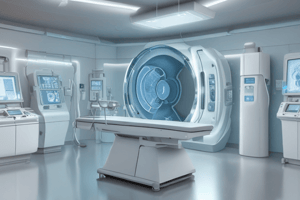Podcast
Questions and Answers
Qual é a principal função das radiografias (X-rays) na medicina?
Qual é a principal função das radiografias (X-rays) na medicina?
- Diagnosticar doenças cardíacas
- Avaliar a função cerebral
- Criar imagens de estruturas internas, como ossos (correct)
- Detectar infecções respiratórias
Qual é o objetivo dos estudos de casos clínicos na radiologia?
Qual é o objetivo dos estudos de casos clínicos na radiologia?
- Realizar intervenções cirúrgicas imediatas
- Demonstrar a eficácia de medicamentos
- Diagnosticar doenças infecciosas
- Prover insights valiosos sobre o uso de técnicas de imagem diagnóstica em cenários clínicos (correct)
Qual é a principal vantagem das tomografias computadorizadas (CT scans) em relação a outras técnicas de imagem?
Qual é a principal vantagem das tomografias computadorizadas (CT scans) em relação a outras técnicas de imagem?
- Limitação para crianças
- Preço elevado
- Invasividade do procedimento
- Rapidez do exame e detalhamento das estruturas internas (correct)
Como os exames de ressonância magnética (MRI) são usados na prática médica?
Como os exames de ressonância magnética (MRI) são usados na prática médica?
O que os estudos de casos reais demonstram sobre a importância da radiologia e imagem diagnóstica?
O que os estudos de casos reais demonstram sobre a importância da radiologia e imagem diagnóstica?
O que é uma tomografia computadorizada (CT)?
O que é uma tomografia computadorizada (CT)?
Qual é a principal vantagem da ressonância magnética (MRI) em relação a outras modalidades de imagem?
Qual é a principal vantagem da ressonância magnética (MRI) em relação a outras modalidades de imagem?
Qual das seguintes condições médicas pode ser diagnosticada com o uso de uma tomografia computadorizada (CT)?
Qual das seguintes condições médicas pode ser diagnosticada com o uso de uma tomografia computadorizada (CT)?
Qual é a principal desvantagem da ressonância magnética (MRI) em comparação com outras modalidades de imagem?
Qual é a principal desvantagem da ressonância magnética (MRI) em comparação com outras modalidades de imagem?
Qual é o papel dos estudos de caso clínicos na radiologia e diagnóstico por imagem?
Qual é o papel dos estudos de caso clínicos na radiologia e diagnóstico por imagem?
Flashcards
CT Scan
CT Scan
A medical imaging technique using X-rays to create detailed cross-sectional images of the body.
MRI
MRI
A non-invasive imaging technique that uses strong magnetic fields and radio waves to create images of the body's internal structures.
X-Ray
X-Ray
A type of electromagnetic radiation used to create images of internal structures, like bones.
Radiology
Radiology
Signup and view all the flashcards
Diagnostic Imaging
Diagnostic Imaging
Signup and view all the flashcards
Medical Imaging
Medical Imaging
Signup and view all the flashcards
Non-invasive
Non-invasive
Signup and view all the flashcards
Appendicitis
Appendicitis
Signup and view all the flashcards
Cancer
Cancer
Signup and view all the flashcards
Fracture
Fracture
Signup and view all the flashcards
Study Notes
Radiology and Diagnostic Imaging: A Comprehensive Guide to CT Scans, MRIs, X-Rays, and Case Studies
Introduction
Radiology is a branch of medicine that involves the diagnosis and treatment of diseases using medical imaging techniques. Imaging modalities include radiographs (X-ray), computed tomography (CT) scans, magnetic resonance imaging (MRI), ultrasound, and other advanced technologies. In this article, we will delve into the world of diagnostic imaging, focusing on CT scans, MRIs, X-rays, and clinical case studies to help readers understand the role of these techniques in medical diagnosis and treatment.
CT Scans
Computed tomography, more commonly known as a CT scan, is a type of medical imaging that uses X-rays to create detailed cross-sectional images of the body. This non-invasive procedure is often used to diagnose and monitor a wide range of medical conditions, including cancer, heart disease, and bone injuries. CT scans can also be used to guide biopsies and other treatments.
MRI
Magnetic resonance imaging (MRI) is a non-invasive imaging technique that uses a strong magnetic field and radio waves to create detailed images of the body's internal structures. MRIs are commonly used to diagnose conditions such as tumors, inflammation, and joint disorders. They are also used to guide procedures such as biopsies and to monitor the effectiveness of treatments.
X-Rays
X-ray is a type of electromagnetic radiation that has the ability to penetrate solid objects, such as the human body. In medicine, X-rays are used to create images of internal structures, such as bones, and are commonly used to diagnose fractures, pneumonia, and other conditions. X-ray imaging is a quick, painless, and relatively low-cost diagnostic tool.
Clinical Case Studies
Real-life case studies can provide valuable insights into the use of radiology and diagnostic imaging in various clinical scenarios. For example, a 2023 study published in the Journal of Radiology demonstrated the effectiveness of using CT scans to diagnose appendicitis in children, while another study in the journal Radiology showed how MRI was used to diagnose a rare lung disorder in a patient with non-specific respiratory symptoms.
Conclusion
Radiology and diagnostic imaging play a crucial role in the diagnosis and treatment of various medical conditions. CT scans, MRIs, and X-rays are non-invasive imaging techniques that provide valuable insights into the body's internal structures, enabling doctors to make informed decisions about patient care. Case studies demonstrate the real-world applications of these imaging modalities and highlight their importance in medical diagnosis and treatment.
Studying That Suits You
Use AI to generate personalized quizzes and flashcards to suit your learning preferences.



